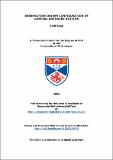Files in this item
Observation-driven configuration of complex software systems
Item metadata
| dc.contributor.advisor | Kirby, Graham N. C. | |
| dc.contributor.author | Sage, Aled | |
| dc.coverage.spatial | viii, 152 p. | en_US |
| dc.date.accessioned | 2015-04-14T10:44:16Z | |
| dc.date.available | 2015-04-14T10:44:16Z | |
| dc.date.issued | 2004-06 | |
| dc.identifier | uk.bl.ethos.644799 | |
| dc.identifier.uri | https://hdl.handle.net/10023/6479 | |
| dc.description.abstract | The ever-increasing complexity of software systems makes them hard to comprehend, predict and tune due to emergent properties and non-deterministic behaviour. Complexity arises from the size of software systems and the wide variety of possible operating environments: the increasing choice of platforms and communication policies leads to ever more complex performance characteristics. In addition, software systems exhibit different behaviour under different workloads. Many software systems are designed to be configurable so that policies (e.g. communication, concurrency and recovery strategies) can be chosen to meet the needs of various stakeholders. For complex software systems it can be difficult to accurately predict the effects of a change and to know which configuration is most appropriate. This thesis demonstrates that it is useful to run automated experiments that measure a selection of system configurations. Experiments can find configurations that meet the stakeholders’ needs, find interesting behavioural characteristics, and help produce predictive models of the system’s behaviour. The design and use of ACT (Automated Configuration Tool) for running such experiments is described, in combination a number of search strategies for deciding on the configurations to measure. Design Of Experiments (DOE) is discussed, with emphasis on Taguchi Methods. These statistical methods have been used extensively in manufacturing, but have not previously been used for configuring software systems. The novel contribution here is an industrial case study, applying the combination of ACT and Taguchi Methods to DC-Directory, a product from Data Connection Ltd (DCL). The case study investigated the applicability of Taguchi Methods for configuring complex software systems. Taguchi Methods were found to be useful for modelling and configuring DC-Directory, making them a valuable addition to the techniques available to system administrators and developers. | en_US |
| dc.language.iso | en | en_US |
| dc.publisher | University of St Andrews | |
| dc.subject | Taguchi | en_US |
| dc.subject | Configuration | en_US |
| dc.subject | Complex | en_US |
| dc.subject | Dynamic | en_US |
| dc.subject.lcc | QA76.76C69S2 | |
| dc.subject.lcsh | Software configuration management | en_US |
| dc.subject.lcsh | Taguchi methods (Quality control) | en_US |
| dc.title | Observation-driven configuration of complex software systems | en_US |
| dc.type | Thesis | en_US |
| dc.contributor.sponsor | Data Connection Ltd. | en_US |
| dc.type.qualificationlevel | Doctoral | en_US |
| dc.type.qualificationname | PhD Doctor of Philosophy | en_US |
| dc.publisher.institution | The University of St Andrews | en_US |
This item appears in the following Collection(s)
Items in the St Andrews Research Repository are protected by copyright, with all rights reserved, unless otherwise indicated.

